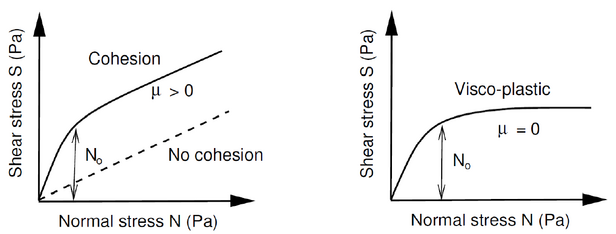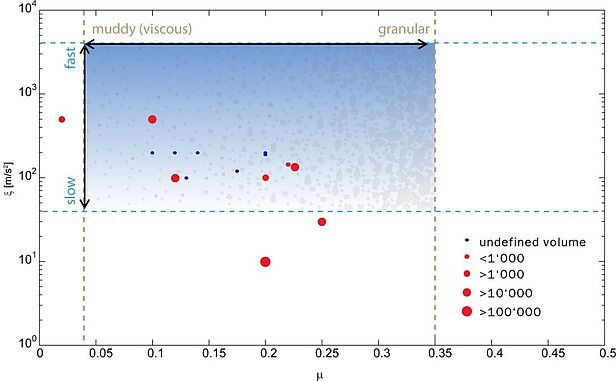RAMMS employs a Voellmy-fluid friction model, which is based on the Voellmy-fluid approach (we refer to Salm et al. 1990 and Salm 1993).
The choice of the friction parameters requires careful calibration of the model by using reference information such as field data, photographs of runout zones, estimations or measurements of flow velocities and flow heights as well as estimations of the material composition. This should be done by an persons with expertise in debris flow characterization.
Physical friction model
The physical model of RAMMS::Debris Flow uses the Voellmy friction law. This model divides the frictional resistance into two parts: a dry-Coulomb type friction (coefficient $μ$) that scales with the normal stress and a velocity-squared drag or viscous-turbulent friction (coefficient $ξ$). The frictional resistance $S$ (Pa) is then
$$S=μN+\frac{ρg {u}^2}{\xi} \qquad \text{with} \qquad N=ρhgcos(φ)$$
where $ρ$ is the density, $g$ the gravitational acceleration, $φ$ the slope angle, $h$ the flow height and $\bf u$ the vector $\bf u=( u_x , u_y )^{T}$, consisting of the flow velocity in the x- and y-directions. The normal stress on the running surface, $ρhgcos(φ)$, can be summarized in a single parameter $N$. The Voellmy model accounts for the resistance of the solid phase ($μ$ is sometimes expressed as the tangent of the internal shear angle) and a viscous or turbulent fluid phase ($ξ$ was introduced by Voellmy by using hydrodynamic arguments). The friction coefficients are responsible for the behavior of the flow. $μ$ dominates when the flow is close to stopping, $ξ$ dominates when the flow is running quickly.
Throughout one simulation, the friction coefficients $μ$ and $ξ$ of a calculation domain are constant. However you have the possibility to add up to two polygons within the calculation domain with different $μ$ and $ξ$ friction parameters.
The Voellmy friction model has found wide application in the simulation of mass movements, especially snow avalanches. For modeling snow avalanches the Voellmy model has been in use in Switzerland for many years and a set of standard parameters is available.
Yield stress
Since Version 1.6.20 the basic Voellmy equation has been modified to include a yield stress (cohesion). Many materials, like mud and snow, do not exhibit a simple linear relation ($μ$ = constant), see Figure below. To model yield stress, we introduce the parameter $N_0$. With this approach it is possible to model ideal plastic materials. In this case $N_0$ serves as a yield stress and $μ$ a "hardening" parameter. The new equation for the frictional resistance $S$ is then
$$S=μN+\frac{ρg {u}^2}{\xi}+(1-μ)N_0-(1-μ)N_0{e}^{-\frac{N}{N_0}}$$
where $N_0$ is the yield stress of the flowing material. Unlike a standard Mohr-Coulomb type relation this formula ensures that $S→0$ when both $N→0$ and $U→0$. It increases the shear stress and therefore causes the debris flow to stop earlier, depending on the value of $N_0$.

Curvature
Since Version 1.6.20, the normal force $N$ includes centrifugal forces arising from the terrain curvature. We use the method proposed by Fischer et al. (2012) which was specifically developed for RAMMS. The centrifugal acceleration $f$ is both a function of the flow velocity and terrain curvature. The acceleration is calculated according to
$$f=uKu^{T}$$
The matrix $K$ describes the track curvature in all directions, including the track “twist”. The centrifugal force is then
$$F=ρhf$$
which is added to the normal force $N$. Typically this increases the friction, causing the flow to slow down in tortuous and twisted flow paths. It can change the location of the deposition once the flow leaves the gully. Curvature may be activated/deactivated in the Run Simulation window (tab Params) or via the menu ‘Help → Advanced… → Curvature’.
Calibration of the friction parameters $μ$ and $ξ$
Although the data base for well documented debris flow events is smaller than the one for snow avalanches, we have a good idea of the friction parameters which have to be used. The major difficulty in case of debris flow simulation is the large variety of debris flow compositions, which has a strong influence on the choice of the friction parameters. RAMMS::DEBRISFLOW uses a single-phase model, so we cannot distinguish between fluid and solid phases and the material is modeled as a bulk flow. Therefore, the friction parameters should be varied to match observed flow properties (for calibrating the model) or expected flow properties (if variation is expected as part of a hazard scenario).
It is common that different events in the same torrent show strong differences in composition. This fact makes the calibration of the friction parameters much more difficult and even requires a calibration for different events. Therefore, we strongly recommend careful calibration of the friction parameters by persons with expertise in debris flow characterization.
